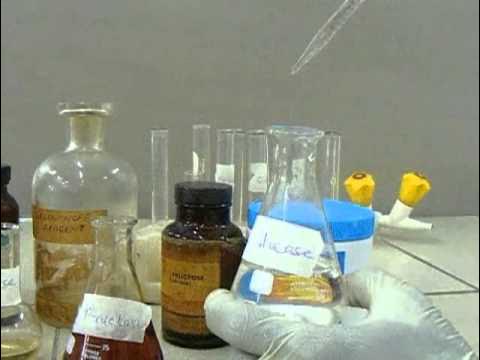GCSE Chemistry - Tests for Anions - Carbonate, Sulfate and Halide Ions #65
Summary
TLDRThis educational video explains how to test for the presence of anions in a solution. It covers three main tests: carbonates, sulfates, and halides. For carbonates, adding dilute hydrochloric acid and observing cloudiness in lime water indicates their presence. Sulfates are detected by adding barium ions to form a white precipitate of barium sulfate. Halide ions are identified by adding silver nitrate, which forms precipitates of different colors depending on the halide: white for chloride, cream for bromide, and yellow for iodide.
Takeaways
- 🧪 The video discusses tests to identify anions in a solution.
- 🌀 A carbonate test involves reacting the sample with acid to produce CO2, which turns lime water cloudy.
- 💧 Lime water turns cloudy if carbonates are present, indicating a positive test result.
- 🔬 The sulfate test has two steps: removing carbonates/sulfites with dilute hydrochloric acid, then adding barium ions to form a white precipitate of barium sulfate.
- ⚗️ A white precipitate indicates the presence of sulfates in the sample.
- 🌈 The halide test involves removing carbonates/sulfites with dilute nitric acid, then adding silver nitrate to form precipitates of different colors depending on the halide ion.
- 🟢 Silver chloride forms a white precipitate when silver ions react with chloride ions.
- 🟤 Silver bromide forms a cream precipitate when silver ions react with bromide ions.
- 🟡 Silver iodide forms a yellow precipitate when silver ions react with iodide ions.
- 📊 The color of the precipitate in the halide test helps identify which halide ion is present.
- 👍 The video encourages viewers to like and subscribe for more informative content.
Q & A
What is the purpose of the tests discussed in the video?
-The purpose of the tests is to check if a solution contains anions, which are negatively charged ions.
What is the first test covered in the video, and how does it work?
-The first test is for carbonate ions. It works by adding dilute hydrochloric acid to the sample, which reacts with carbonates to produce carbon dioxide gas. The presence of carbon dioxide is confirmed by bubbling the gas through lime water, which turns cloudy if carbonates are present.
What happens when carbon dioxide gas is bubbled through lime water?
-When carbon dioxide gas is bubbled through lime water, it turns the lime water cloudy, indicating the presence of carbonates in the original sample.
How does the sulfate ion test differ from the carbonate ion test?
-The sulfate ion test involves adding barium ions to the sample, which react with sulfate ions to form a white precipitate of barium sulfate. This is different from the carbonate ion test, which relies on the formation of carbon dioxide gas.
Why is dilute hydrochloric acid added before adding barium ions in the sulfate ion test?
-Dilute hydrochloric acid is added before barium ions to remove any carbonate or sulfite ions, which could also react with barium ions to form a white precipitate and confuse the results.
What is the significance of a white precipitate forming during the sulfate ion test?
-The formation of a white precipitate during the sulfate ion test indicates a positive result, meaning that sulfate ions are present in the sample.
How does the halide ion test differ from the sulfate ion test in terms of reagents used?
-In the halide ion test, dilute nitric acid is used instead of dilute hydrochloric acid to remove impurities, and silver nitrate is used instead of barium chloride to react with halide ions.
What colors of precipitates can be formed during the halide ion test, and which halide ions do they correspond to?
-During the halide ion test, a white precipitate corresponds to chloride ions, a cream precipitate to bromide ions, and a yellow precipitate to iodide ions.
Why is the halide ion test also called the silver nitrate test?
-The halide ion test is called the silver nitrate test because it involves the use of silver nitrate, which reacts with halide ions to form precipitates of different colors.
What is the final step to confirm the presence of halide ions in the sample?
-The final step to confirm the presence of halide ions is to observe the color of the precipitate formed after adding silver nitrate; different colors indicate different halide ions.
What is the main takeaway from the video regarding the testing of anions in a solution?
-The main takeaway is that specific chemical tests can be used to identify the presence of anions such as carbonates, sulfates, and halides by observing changes in the solution like cloudiness or color of precipitates.
Outlines

Cette section est réservée aux utilisateurs payants. Améliorez votre compte pour accéder à cette section.
Améliorer maintenantMindmap

Cette section est réservée aux utilisateurs payants. Améliorez votre compte pour accéder à cette section.
Améliorer maintenantKeywords

Cette section est réservée aux utilisateurs payants. Améliorez votre compte pour accéder à cette section.
Améliorer maintenantHighlights

Cette section est réservée aux utilisateurs payants. Améliorez votre compte pour accéder à cette section.
Améliorer maintenantTranscripts

Cette section est réservée aux utilisateurs payants. Améliorez votre compte pour accéder à cette section.
Améliorer maintenantVoir Plus de Vidéos Connexes

GCSE Biology Revision "Required Practical 4: Food Tests"

O-Level Chemistry . IP Chemistry: Selective Discharge of Ions in Electrolytic Cells – Part 1

Seliwanoff''s Test - Qualitative Test for Carbohydrates

Biuret's Test

TESTING MY URINE FOR SUGAR & PROTEIN | Nursing Experiment | Lancetti

Naming Binary Ionic Compounds Containing Fixed Oxidation State Cations (Screencast)
5.0 / 5 (0 votes)
